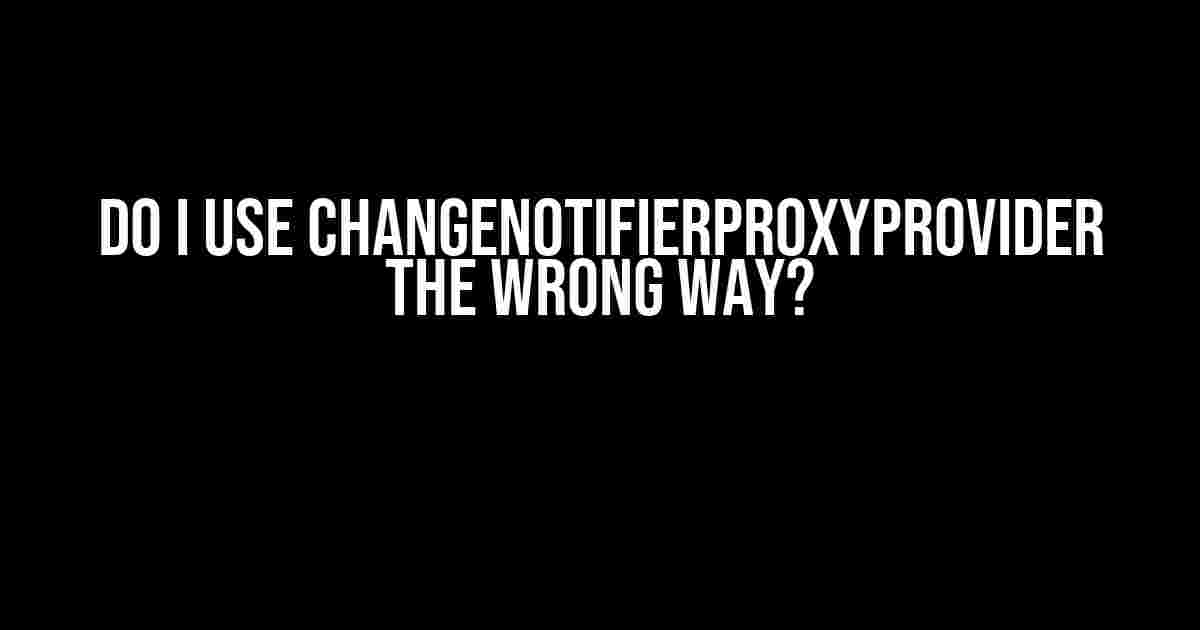Are you struggling to get ChangeNotifierProxyProvider to work its magic in your Flutter app? You’re not alone! Many developers have been there, done that, and got the t-shirt. In this article, we’ll dive deep into the world of ChangeNotifierProxyProvider and explore common mistakes, best practices, and troubleshooting tips to help you master this powerful tool.
What is ChangeNotifierProxyProvider?
Before we dive into the nitty-gritty, let’s take a step back and understand what ChangeNotifierProxyProvider is and why it’s so important in Flutter.
ChangeNotifierProxyProvider is a provider that wraps around another provider, allowing you to create a proxy that listens to changes in the wrapped provider. It’s a powerful tool for managing state and handling dependencies in your app. By using ChangeNotifierProxyProvider, you can create a single source of truth for your app’s state and ensure that your widgets are always up-to-date.
Common Mistakes to Avoid
Now that we’ve covered the basics, let’s explore some common mistakes developers make when using ChangeNotifierProxyProvider:
-
Failing to Initialize the Provider
One of the most common mistakes is failing to initialize the provider correctly. Make sure you’ve added the provider to your widget tree and that it’s properly configured.
void main() { runApp( MultiProvider( providers: [ ChangeNotifierProxyProvider<AuthenticationService, UserID>( create: (_) => AuthenticationService(), update: (_, auth, userID) => userID ?? AuthenticationService().update(userID), ), ], child: MyApp(), ), ); } -
Incorrectly Configuring the Provider
Another mistake is incorrectly configuring the provider. Double-check that you’ve set up the provider correctly, including the type of the provider and the update function.
ChangeNotifierProxyProvider<AuthenticationService, UserID>( create: (_) => AuthenticationService(), update: (_, auth, userID) => userID ?? AuthenticationService().update(userID), ) -
Not Handling Null Values
Make sure you’re handling null values correctly in your provider. Failing to do so can lead to unexpected behavior and errors.
update: (_, auth, userID) => userID ?? AuthenticationService().update(userID),
Best Practices for Using ChangeNotifierProxyProvider
Now that we’ve covered common mistakes, let’s explore some best practices for using ChangeNotifierProxyProvider:
-
Keep Your Provider Simple
Keep your provider simple and focused on a single responsibility. Avoid complex logic and keep your provider lean and mean.
-
Use a Single Source of Truth
Use a single source of truth for your app’s state. This will help you avoid inconsistencies and ensure that your widgets are always up-to-date.
-
Handle Errors and Exceptions
Handle errors and exceptions correctly in your provider. This will help you avoid unexpected behavior and ensure that your app remains stable.
-
Test Your Provider Thoroughly
Test your provider thoroughly to ensure it’s working as expected. Write unit tests and integration tests to cover all scenarios.
Troubleshooting Tips
Stuck with an issue? Don’t worry, we’ve got you covered! Here are some troubleshooting tips to help you fix common problems:
| Problem | Solution |
|---|---|
| Provider not updating correctly | Check that you’ve set up the provider correctly, including the type of the provider and the update function. |
| Widgets not updating | Check that you’ve wrapped your widgets with the provider correctly and that the provider is being rebuilt correctly. |
| Error handling not working | Check that you’ve implemented error handling correctly in your provider and that you’re catching and handling exceptions correctly. |
Conclusion
ChangeNotifierProxyProvider is a powerful tool for managing state and handling dependencies in your Flutter app. By following best practices, avoiding common mistakes, and troubleshooting issues correctly, you can master this tool and take your app to the next level. Remember to keep your provider simple, use a single source of truth, handle errors and exceptions, and test your provider thoroughly. With practice and patience, you’ll be a pro at using ChangeNotifierProxyProvider in no time!
So, do you use ChangeNotifierProxyProvider the wrong way? If you’re still struggling, don’t worry! Take a step back, review your code, and try again. With this article, you’ve got the knowledge and expertise to master ChangeNotifierProxyProvider and create a robust, scalable, and maintainable Flutter app.
Frequently Asked Question
Are you stuck with ChangeNotifierProxyProvider and wondering if you’re using it the wrong way?
Q1: I’m getting a strange error when using ChangeNotifierProxyProvider, what’s going on?
A1: Ah, don’t worry! It’s probably because you’re not providing the correct type to the `ChangeNotifierProvider` widget. Make sure you’re passing the correct type of your ChangeNotifier class to the provider. For example, if your ChangeNotifier class is `MyNotifier`, you should pass `MyNotifier` to the provider, not `ChangeNotifier`. Easy peasy!
Q2: I’m trying to use ChangeNotifierProxyProvider with a Future, but it’s not working, help!
A2: Yeah, that can be tricky! When using ChangeNotifierProxyProvider with a Future, you need to make sure you’re handling the loading state correctly. You can do this by using the `ProxyProvider`’s ` lazy` property and checking if the Future has completed before trying to access the data. Give it a try and see if that solves the issue!
Q3: Can I use ChangeNotifierProxyProvider with a Stream?
A3: Absolutely! ChangeNotifierProxyProvider works beautifully with Streams. Just make sure you’re using the `AsyncValue` widget to handle the Stream’s data and errors. Easy as pie!
Q4: I’m getting a ‘ProviderNotFoundException’ when using ChangeNotifierProxyProvider, what’s wrong?
A4: Oops, that’s a common mistake! It means you’re trying to access the ChangeNotifierProxyProvider before it’s been created. Make sure you’ve added the provider to the widget tree above where you’re trying to use it. You can do this by wrapping your `MaterialApp` with the `ChangeNotifierProvider` widget.
Q5: Can I use ChangeNotifierProxyProvider with multiple providers?
A5: Yep, you can! ChangeNotifierProxyProvider is designed to work with multiple providers. Just make sure you’re providing the correct types to each provider and that they’re correctly nested in your widget tree. With a little practice, you’ll be a pro at using multiple providers in no time!
